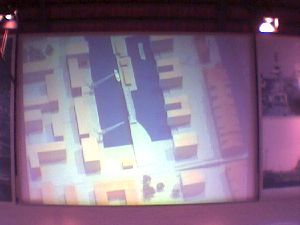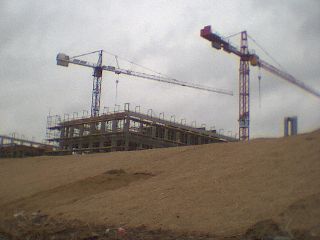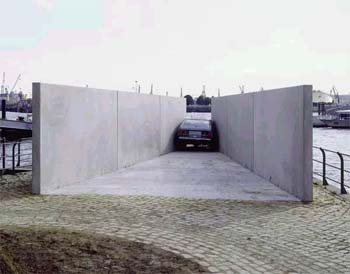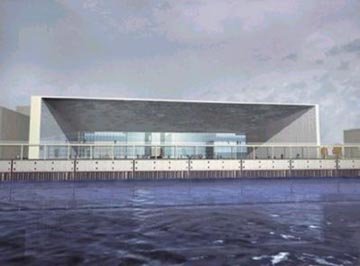![[Home]](../bilder/r2c-head1a.gif) HafenCity
HafenCity![[Home]](../bilder/r2c-head1a.gif) HafenCity
HafenCity|
[数据恢复 硬盘恢复] [数据恢复 硬盘修复] [raid数据恢复] [硬盘修复] [raid数据恢复] |
HafenCity is a plan of the City of Hamburg with the aim to double the innercity space and thereby install a totally new city area. By selling the ground to investors the initial idea of the city was to finance the new container terminal in Altenwerder which was put into operation fall 2002. HafenCity will be build in the old harbour area (freeport) and is one of the largest urban development projects in Europe. It is advertised as an area of "an urban and lively mix of housing, working, commerce, tourism and leisure". The whole process is scheduled for about 25 years. Up to now, without considering the official centre of information with its huge model from the HafenCity, the only finished and recently inaugurated building is the SAP Training-Center.
Questions: Why shall the HafenCity be built? Who builds and for whom? Which perspective is taken and therefore realized? Who is meant to use the area? Which possibilities are offered in the HafenCity? Which ideas and concepts of urbanism are determinant? These and other questions concerning cultural, social and aesthetic implications have been subject of the TetraPak/ artgenda 2002 platform ReadyToCapture.
# Informations available at different websites HafenCityimNetz |
# Let google search for [HafenCityPics] or for [HafenCity]
# Daily news in the german print-media [Paperball] |
# Selection of articles HafenCityNews | # Hafencity in the [Newspaper Archives]
# Official Webpage [www.hafencity.com] | # Search and find sites and locations [CityMap] | # Google-newsgroups [de.sci.architektur]
 Destruction of the industrial leftovers of the freetrade harbour
Destruction of the industrial leftovers of the freetrade harbour
HafenCity or HafenVillage? It´s still not clear if "one of the largest urban development project of europe" will succeed or fail. Untill now the city of Hamburg has been investing: First to resettle various firms and companies those have been located in the freetrade harbour, second because the costs to prepare this former industrial area for constructions are high. The soil is quite unstable, special pile dwellings are needed and it is necessary to protect all buildings against the danger of flooding.
Smaller investors or cooperative building associations hardly can afford to build. Therefore most of the few actual projects are initiated by international companies, investment groups, banks or exclusive local real-estate investors. The financing of the container terminal in Altenwerder meanwhile has been declared obsolete. New communal investments for infrastructure of the City of Hamburg are necessary to drive the slow development process of the HafenCity.
# Texts about the HafenCity and other harbour restructuring projects TextProduktion | # Informations about other HarbourRestructuringCities

Residential blocks and office buildings for exclusive clients, shall be build at Am Sandtorkai. In August 2001, the area has been handed over to the investors, but not any of the projects has been realized yet.
The GHS (Gesellschaft für Hafen- und Standortentwicklung), a former subsidiary company of the HHLA (Hamburger Hafen- und Lagerhaus AG), is the official developer of the HafenCity. It is an independent, 100% city-owned Gmbh and holds the real-estates of the >City and Port Assets< in trust. Marketing and estate-management have been totally given to the GHS. The political commission given by the City of Hamburg to the GHS is profit-oriented: To make money by selling estates to private investors. The official competent authority for the GHS is the administration of economy, however, in practical terms, it is not bound to their instructions. Senators of three municipal administrations (economy, finance and construction) are members of the supervisory board of the GHS. The political control of the GHS is acted out via the senate (and therefore by the actual government coalition) and not via the citizenry (the parliament, i.e. the current opposition is excluded from influence). The supervisory board of the GHS has the power to dismiss the managing director (if wanted), while the senate is able to change the political commission (if intended).
The GHS runs an information-center at the KesselHaus (owned by the HHLA) at Am Sandtorkai as an official marketing tool, similar to the former Infobox at Potsdamer Platz in Berlin. An important part of the marketing-concept of the KesselHaus is the huge, so called "interactive" (you can zoom in via cameras) HafenCityModell, that depicts the vision of the MasterPlan of the HafenCity. Public participation and concept-transparency are fictious: The MasterPlan refers to a public planning-dialogue, which never took place. The KesselHaus is described as a public place for discussions about the HafenCity, but there are no mechanisms to organize such a process.
# Hamburger Hafen- und Lagerhaus AG [HHLA] | # Municipal information about commerce and harbour at [hamburg.de]
# Hafencity information-center and marketing tool KesselHaus | # Official HafenCityModell | # GHS-Info in german [Die GHS]
 Model-screen in the Kesselhaus of the GHS
Model-screen in the Kesselhaus of the GHS
Hamburg applied for the olympic games in 2012 - the southeast part of the HafenCity would have been the place for the olympic village. The olympic games were considered necessary to speed up the developmental process of the HafenCity. But in April 2002 Leipzig won the pre-elections of the german city-candidates.
# Anti-image-campaign [NOlympia] | # Hafencity and Olympia [Schöne neue Modellwelt] [Der geheime Plan des Henning Voscherau]
# Marketing campaign for Olympia 2012 in Hamburg [Feuer und Flamme]
# National olympic committee for Germany [NOC for Germany]
# Roundtrip over the Olympic Center [flight-animation] | # Effects of the olympic games in previous cities [Olympia - der große Wurf?]
 Model for the olympic games 2012 in Hamburg in the Hafencity
Model for the olympic games 2012 in Hamburg in the Hafencity
The HafenCity as an urban model puts an emphasis on the new media industry (the so called "New Economy"), it´s clients and employees. In this sense the basic urban model for the HafenCity was the MedienStadt. An important, and still unrealized part of this concept is the "autonomous MediaCity", the MediaCityPort, a project developed especially for the new media, which should replace the KaispeicherA. Since the NewEconomyCrisis and the crash of it´s stockmarket (the "famous" Neuer Markt) the whole project HafenCity has to be redefined. Even the FirstBuilding of the HafenCity has not been built by the german software corporation SAP itself.
# End of immaterial production NewEconomyCrisis | # Say goodbye: Internetportal of [Neuer Markt] | # Software cooperation SAP
# SAP´s clients academy FirstBuilding | # Symbol for the Hafencity MediaCityPort | # Defintions, links and literature MedienStadt and DigitalCity
 Former construction site of the SAP-office buliding
Former construction site of the SAP-office buliding
Art and culture play a very important role in the concept of the HafenCity as an image product. TetraPak was discussing continously if our project ReadyToCapture would - as we know by experience and the gentrification debate of the last years - be integrated in the process of image-production easily or if there were any chances to comment and analyze the development of the HafenCity and it´s politics - and, by doing so, opening up the space for alternatives.
The discussion about a [sculpture by Jeff Koons] for the central square "Spielbudenplatz" in Hamburg-St.Pauli shows the ideological rollback in the idea of public art in Hamburg. It marks the function art has within the now dominating debate about the whole City of Hamburg as an international brand.
# Culturual projects and art in the Hafencity CulturalGentrificationHafenCity | # Sociological definition of [Gentrification]
# Gentrification-effects on the neighbouring district SüdlicheNeustadt? | # Bibliography Gentrification [Armut und Reichtum in der Großstadt]
# Trying to reanimate the [City Nord], a big urban development project in Hamburg by cultural gentrification [Die Kunst geht in die City Nord]
 >Engpass< (Kehrwiederspitze) von Roman Signer. Aussendient - Kunst im Öffentlichen Raum
>Engpass< (Kehrwiederspitze) von Roman Signer. Aussendient - Kunst im Öffentlichen Raum
Apart from contemporary art and culture, a cruise terminal, a russian submarine, [bungeee jumping], trendy parties and more represent the common means of promotion for the HafenCity as an EventCity, similar to those you can find in most of the HarbourRestructuringCities. The center of urban cultural life shall be the so called ÜberseeQuartier?. Although the old >Musikhalle< is actually under renovation, a new concert hall for classical music combined with a seawater aquarium is discussed vividly.
The situation of BlindePassagiere (stowaways) and refugees obviously does not go with the image of an EventCity. The proposal to tow the boat BibbyAltona, where immigrants are accomodated, to the Baakenhafen in the area of the HafenCity is quite surprising. But in the debate about a new location for the BibbyAltona, the HafenCity is considered nothing more but an interim solution. Otherwise it would damage the development of the HafenCity.
# Cruise Terminal [HafenCity Kreuzfahrtterminal] | # RussianSubmarineU434 | # HafenCityClubScene | # Promotion company EventLabs
# Articles about the new concert hall [1] [2] | # Situation of stowaways BlindePassagiere | # Ships for immigrants BibbyAltona
 Simulation of the cruise terminal by RKW
Simulation of the cruise terminal by RKW